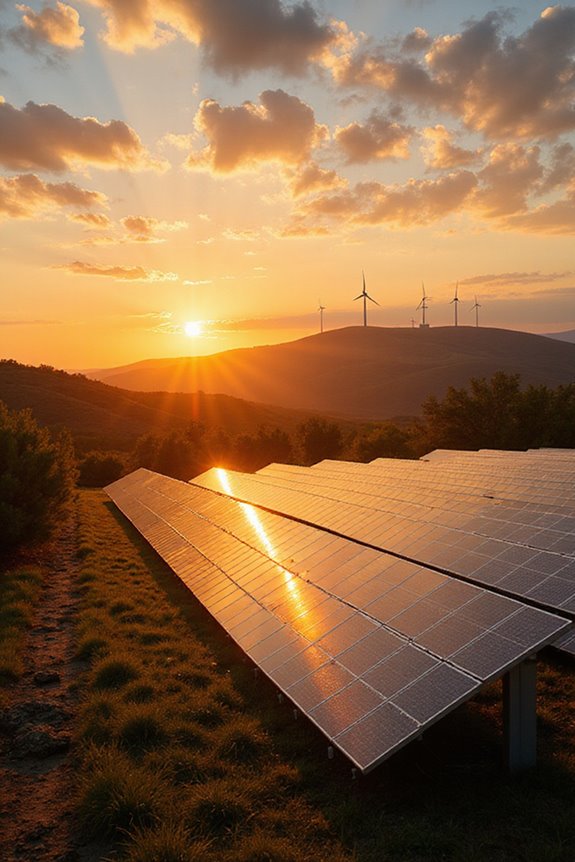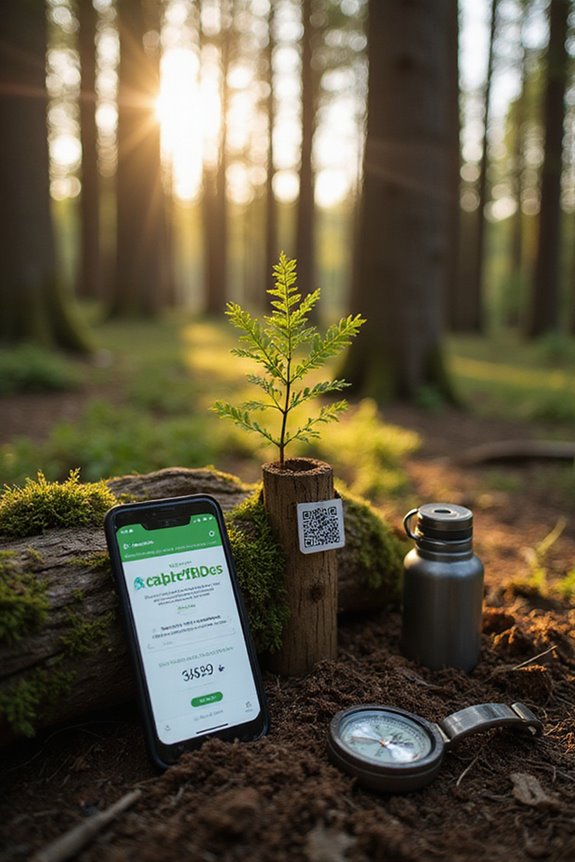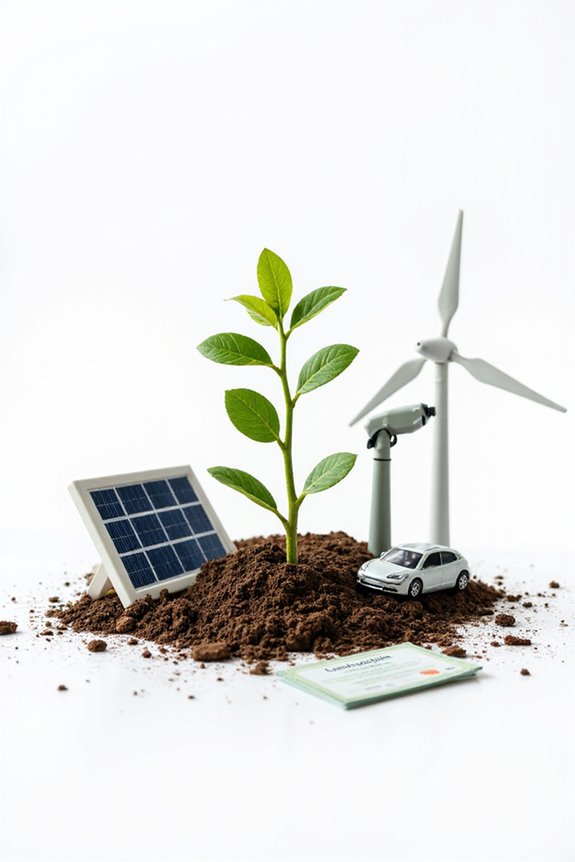To offset carbon emissions effectively, one can explore a mix of innovative techniques. Carbon Capture and Storage (CCS) grabs CO2 before it escapes, while nature-based solutions, like reforestation, restore habitats and absorb carbon. Upgrading energy efficiency, using renewables, and engaging in community projects further help. Think tree planting or solar initiatives that not only reduce CO2 but also foster local pride. There’s so much more to discover about making a real difference in the environment.
Key Takeaways
- Invest in carbon capture and storage (CCS) projects to reduce industrial emissions and store CO2 effectively.
- Support renewable energy initiatives like solar and wind to replace fossil fuel usage.
- Participate in reforestation and preserve existing forests to enhance carbon sequestration and biodiversity.
- Engage in community carbon offset programs that support local sustainability projects and create economic opportunities.
- Adopt energy-efficient practices at home, such as upgrading appliances and improving insulation to lower overall emissions.
Carbon Capture and Storage Offsets
Carbon capture and storage (CCS) offsets are like superhero sidekicks in the battle against climate change, swooping in to save the day by reducing carbon emissions from heavy-duty industrial sources. By capturing carbon dioxide before it escapes into the atmosphere, CCS plays an essential role in tackling greenhouse gases. Techniques like post-combustion and pre-combustion capture help snag that CO2. Yet, it’s not all smooth sailing; storage challenges loom large. High costs, public skepticism about leaks, and the intricate tech involved can make CCS feel like a formidable task. Still, with around 45 million tons of CO2 stored annually, equivalent to the emissions of 10 million cars, the potential impact is immense—making CCS a critical piece of the climate puzzle.
Energy Carbon Offset Projects

While many people might think of energy carbon offset projects as just another buzzword in the climate change conversation, they actually represent a powerful toolkit for reducing emissions and promoting sustainability. These projects focus on enhancing energy efficiency in everyday life, like upgrading household appliances or improving building insulation, which can greatly lower CO2 emissions. On the renewable energy front, harnessing solar, wind, and hydroelectric power helps replace fossil fuels, paving the way for a cleaner future. Additionally, waste-to-energy initiatives transform non-recyclable materials into energy, cutting down landfill emissions. By embracing these strategies, communities can foster a healthier planet, proving that small changes can lead to big impacts. It’s about turning potential into action, one project at a time!
Nature-Based Solutions

Nature-based solutions offer a rejuvenating approach to tackling climate change, and they’re not just about planting trees—though that’s a big part of it! These strategies include reforestation, which captures carbon while also restoring habitats and engaging local communities. Imagine vibrant forests brimming with life, all while preventing soil erosion and enhancing water quality. They also encompass coastal ecosystems like mangroves, acting as natural shields against storms and flooding. By protecting existing forests, we preserve essential carbon stores and support biodiversity. Regenerative agriculture, with its focus on healthy soils, improves crop yields and reduces reliance on synthetic inputs. Ultimately, these nature-based benefits not only combat climate change but also create a sustainable future for us all.
Technology-Based Offsets

In today’s world, innovative technology plays a pivotal role in combating climate change, and it’s exciting to see how various tools and techniques come together to create a brighter future. Technologies like satellite monitoring and drones are revolutionizing carbon tracking, offering real-time insights into emissions and carbon sequestration. Meanwhile, artificial intelligence processes massive data streams to enhance accuracy, predicting future climate scenarios and evaluating offset effectiveness. Direct Air Capture (DAC) and Carbon Capture and Storage (CCS) provide tangible methods for removing CO2 from our atmosphere. To top it off, blockchain verification promotes transparency in carbon offset trading, ensuring that every credit is genuine. With these advancements, tackling climate change feels more achievable than ever, turning hope into action.
Carbon Offset Programs

Carbon offset programs offer a fascinating way for individuals and businesses to tackle their carbon footprints. These platforms manage and vet carbon offset certifications, providing credits that can help neutralize emissions. Whether it’s investing in tree planting or renewable energy, these credits support projects that genuinely reduce CO2. With a growing interest in voluntary market trends, more people are participating in these initiatives, making a positive impact on the planet. Programs like Terrapass and Persefoni’s Zero-Commission Carbon Offset Marketplace are shining examples, showcasing how impactful investments can be. Not only do these projects aim to stabilize atmospheric CO2, but they also boost local economies and foster biodiversity. By embracing carbon offset programs, everyone can contribute to a greener future.
Global Carbon Offset Initiatives
How does the world tackle the urgent challenge of climate change while fostering economic growth? Global carbon offset initiatives are stepping up, merging compliance mechanisms with voluntary efforts. The expanding interlinkage between these markets is essential, as countries like China ramp up their carbon trading systems, pushing for higher prices and greater participation. For instance, the Clean Development Mechanism (CDM) has issued over 2 billion credits, focusing on projects like Malawi’s cookstove program, which benefits local communities too. Meanwhile, the EU’s upcoming Carbon Border Adjustment Mechanism (CBAM) aims to influence global exporters by adding costs on carbon in imports. As these initiatives flourish, they create a vibrant tapestry of global market integration, driving innovation while tackling emissions head-on.
Quick Emissions Reduction Methods
Every little bit counts when it comes to reducing carbon emissions, and countless quick changes can make a significant impact. Simple transportation alternatives, like walking, biking, or using public transit, can drastically cut down vehicle use. Carpooling is another smart move, as it packs more people into fewer cars, keeping emissions low. At home or work, energy savings can be achieved by switching off lights and opting for energy-efficient appliances. Lowering thermostats and using fans can help, too! Even small adjustments, like shorter showers or fixing leaks, can contribute to a greener planet. By embracing these quick changes, individuals can play a pivotal role in lowering carbon footprints and protecting the environment for future generations.
Cost-Effective Carbon Reduction Strategies
While many might think that reducing emissions requires a hefty budget or extensive resources, the truth is that there are plenty of cost-effective strategies that anyone can embrace. For starters, energy efficiency improvements, like swapping out old light bulbs for LEDs or installing programmable thermostats, can make a surprising impact without breaking the bank. Real-time energy management platforms powered by AI can help streamline energy use, making it easier to monitor and reduce waste. Then there’s renewable integration; incorporating solar panels or wind turbines can not only lower emissions but also enhance energy security. With government incentives often available, these upgrades become even more feasible, proving that small changes can lead to big results in the fight against climate change.
Enhancing Carbon Sinks
Carbon sinks play an essential role in the fight against climate change, often working quietly behind the scenes to absorb the carbon dioxide that humans release into the atmosphere. Forest preservation is significant since forests store about one-third of global annual emissions, acting like nature’s sponges. However, it doesn’t stop there; healthy soils are equally important. Through proper soil management, farmers can enhance carbon storage, ensuring our earth remains a thriving habitat. Wetlands and peatlands also deserve special attention, as their unique ecosystems trap carbon effectively. By combining efforts in these areas, we can create a powerful coalition against climate change. After all, nurturing our natural carbon sinks isn’t just a task; it’s a responsibility we all share for future generations.
Community Empowerment Through Carbon Offsetting
When communities come together to tackle carbon offsetting, the impact can be transformative, reshaping not just the environment but the very fabric of local lives. Engaging local voices in these projects fosters a sense of ownership, allowing for truly sustainable livelihoods. For instance, programs that train residents in renewable energy or sustainable agriculture do more than reduce emissions; they empower individuals with skills that spark innovation. Imagine a village where solar cookers are made and sold locally, or where biogas plants create jobs and clean energy. This blend of community engagement and environmental responsibility nurtures resilience and prosperity. Ultimately, carbon offsetting isn’t just about planting trees; it’s about growing stronger, more vibrant communities ready to face future challenges together.
Frequently Asked Questions
How Can Individuals Participate in Carbon Offset Programs?
Individuals can actively participate in carbon offset programs through personal actions, such as purchasing credits, and by engaging in community initiatives that promote sustainability. These efforts foster environmental responsibility and support local projects that benefit ecosystems and communities.
Are Carbon Offsets a Long-Term Solution to Climate Change?
Carbon offsets alone are not a long-term solution to climate change. Achieving carbon neutrality requires integrating sustainable practices alongside offsets, ensuring significant emissions reductions and fostering ongoing evaluation of projects for effective environmental impact.
What Is the Difference Between Carbon Credits and Carbon Offsets?
In the vast universe of carbon market dynamics, carbon credits focus on reducing emissions, while carbon offsets emphasize greenhouse gas removal. Understanding these distinctions is essential for effective sustainability practices and achieving meaningful environmental impact.
How Are the Effectiveness of Carbon Offset Projects Measured?
The effectiveness of carbon offset projects is measured through carbon project verification and offset impact assessment, focusing on accurate baselines, additionality, independent verification, and quantifiable emissions reductions to guarantee genuine environmental benefits.
Can Carbon Offsets Be Purchased for Personal Travel Emissions?
Carbon offsets can indeed be purchased for personal travel emissions. By investing in certified projects, individuals can effectively reduce their carbon footprint, contributing to initiatives that mitigate environmental impacts associated with their travel activities.





